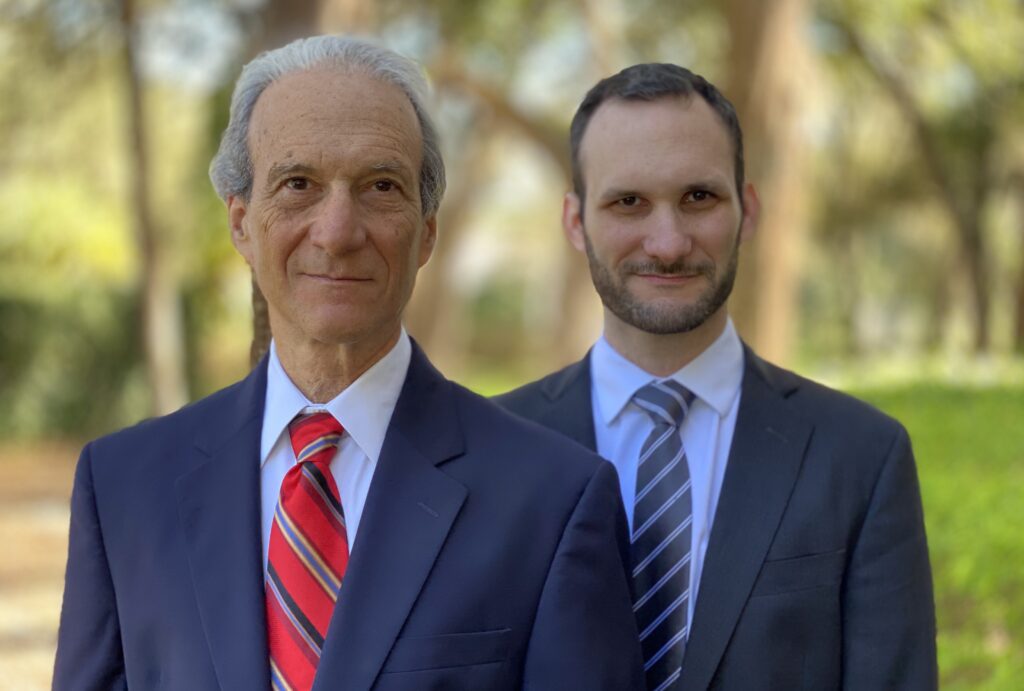Pros and Cons of Living Trusts
What Is a Living Trust in Florida?
A Florida living trust allows people to manage their assets during their lifetime while specifying how they will be distributed after their death.
In Florida, a living trust bypasses probate, offers privacy, and streamlines asset distribution. It can also help provide for the trustmaker during their incapacity.
How Living Trusts Work
A Florida living trust is a legal tool that manages your assets during your lifetime, ensures they are distributed to your beneficiaries after death, and avoids probate for trust assets. A living trust in Florida is typically revocable, which means you can modify or terminate it at any time.
A living trust involves three key roles:
- Grantor – The person who creates the trust.
- Trustee – The person who manages the trust assets.
- Beneficiaries – The individuals who receive the assets.
Why Use a Living Trust?
The primary reason to set up a living trust is to avoid probate. Probate is the legal process of validating a will, paying debts, and distributing assets to heirs. However, probate can be:
- Time-Consuming – It can take months or even years to finalize.
- Costly – Court fees and attorney costs can significantly reduce the estate’s value.
- Public – Probate records are public, exposing details of the estate.
Assets held in a living trust bypass probate, allowing for quick and private distribution to beneficiaries.

Providing for Children with a Living Trust
A living trust is especially useful for parents of minor children or young adults. In your trust agreement, you can specify:
- The ages or milestones when your children will receive assets.
- Guidelines for managing assets to provide for their care, education, and well-being until they reach a suitable age.
This control ensures children are financially supported in their younger years and protects their inheritance from being mismanaged.
We help families throughout Florida.
Our attorneys can help with your entire estate plan. We can provide all services remotely. Start with a free phone or Zoom consultation.

How to Create a Trust in Florida
Creating a living trust in Florida is one of the most effective ways to avoid probate and control how your assets are managed during your lifetime and after your death. A Florida living trust lets you keep ownership and use of your assets while you’re alive and appoints a successor trustee to manage the assets if you become incapacitated or pass away.
In Florida, the process of setting up a revocable living trust involves several legal steps. A properly drafted trust should comply with Florida law, clearly identify the trustmaker (also called the grantor), trustee, successor trustee, and beneficiaries, and outline how assets are to be distributed.
Steps to Create a Living Trust in Florida
1. Choose Between an Individual or Joint Trust
If you’re single, you’ll create an individual trust. Married couples often choose to create a joint trust, especially when they own most assets together. The structure affects how assets are titled and distributed.
2. Draft the Trust Document
A Florida trust attorney will draft the living trust according to your wishes. The trust should identify:
- You as the grantor
- You or someone you choose as the trustee
- A successor trustee who takes over upon your death or incapacity
- Your beneficiaries and how the assets will be distributed
The language must comply with Florida’s Trust Code to be legally enforceable.
3. Sign the Trust Properly
In Florida, the trust agreement must be signed in the presence of a notary and two witnesses. Although Florida law does not require this for a revocable trust, having it properly executed like a will avoids disputes and makes it easier to prove the trust’s validity later.
4. Fund the Trust
Funding the trust means transferring assets into the trust’s name. Commonly included assets are:
- Real estate (with a new deed)
- Bank accounts (by retitling them or making the trust the payable-on-death beneficiary)
- Investment accounts and brokerage holdings
- Business interests or LLCs
- Personal property
Unfunded trusts offer no probate avoidance and limited incapacity planning.
5. Update Your Estate Plan
A complete Florida estate plan usually includes a pour-over will, durable power of attorney, and health care directives. The pour-over will ensures that any assets not titled in the trust are still distributed according to your wishes.
How to Fund a Living Trust
Funding a living trust in Florida means transferring ownership of your assets into the name of the trust so they can be managed and distributed according to the terms you’ve set. Living trusts can be funded when the trust is created, over time, upon incapacity, or upon death.Here are the main ways to fund a Florida living trust:
1. Real Estate:
You transfer ownership of your Florida home or other properties by recording a deed (typically a warranty deed or quitclaim deed) naming the trust as the new owner. For homestead property, additional care is needed to preserve Florida’s homestead protections.
2. Bank Accounts and Brokerage Accounts:
Accounts can be retitled in the name of the trust by working with your financial institution. Alternatively, you can name the trust as the payable-on-death (POD) or transfer-on-death (TOD) beneficiary.
3. Vehicles and Personal Property:
Personal property (like furniture, jewelry, or collectibles) can be transferred through a general assignment of personal property to the trust. For vehicles, you should weigh whether transferring title is practical, as it may affect insurance or taxes.
4. Business Interests:
Shares in closely held corporations, membership interests in LLCs, or partnership interests can be transferred to a trust by assigning the ownership rights and updating company records, often with approval under operating agreements.
5. Life Insurance and Retirement Accounts:
You usually don’t retitle these to the trust. Instead, you name the trust as a beneficiary, especially if you want to control the timing of distributions to minor children or protect beneficiaries from creditors.
Requirements for Living Trusts in Florida
Here are the primary requirements for a Florida living trust to be valid:
- It must be in writing. Florida does not recognize oral trusts for assets meant to be transferred after the grantor’s death.
- You must have legal capacity. The person creating the trust (often called the “settlor” or “grantor”) must be of sound mind.
- It must have a beneficiary. There must be a definite beneficiary or beneficiaries unless the trust is a charitable trust, a trust for the care of an animal, or another non-charitable trust with a specific purpose.
- It must have a proper purpose. The trust must have a lawful purpose. A trust won’t be valid if its purpose is illegal or against public policy.
- It must appoint a trustee. The trust must have a named trustee. This can be the person creating the trust (for a living trust) or another individual or entity. The trustee must accept the responsibility, and there must be some duties for the trustee to perform (no “honorary” trusts). If a trustee is not named or the named trustee declines to serve, a court may appoint one.
- It must be funded. While not a requirement for the trust’s creation, for the trust to be effective, it needs to be “funded.” This means that assets (like real estate, bank accounts, or other property) must be legally transferred into the trust. If assets are not transferred to the trust, they will not be governed by its provisions.
- It must be properly executed. For a revocable living trust to be valid in Florida, it generally needs to be executed with the same formalities as a will in Florida. This means the settlor must sign the trust document, and the signing must be witnessed by two witnesses, all being in the presence of each other. The execution must also be notarized.
- You do not need court approval: Unlike some legal documents, a living trust doesn’t need court approval to be valid. However, after the settlor’s death, certain notifications may need to be provided, and if there are disputes, the court might be involved.
Pros and Cons of Establishing a Living Trust
Advantages
Here are the key benefits of establishing a living trust in Florida:
- Avoids Probate: One of the primary benefits of a living trust in Florida is avoiding probate. Probate can be time-consuming, expensive, and public. By transferring assets into a living trust, they can be distributed to beneficiaries upon the grantor’s death without going through probate.
- Adds Privacy: Since probate is a public process, all documents, including the will and the list of assets, become part of the public record. On the other hand, a living trust remains private, ensuring that details about the grantor’s assets and to whom they’re distributed remain confidential.
- Allows Asset Management During Incapacity: If the grantor becomes mentally incapacitated due to illness, injury, or other reasons, the named successor trustee can manage the assets in the trust without needing a court-appointed guardian or conservator.
- Provides Flexibility: A living trust can be modified during the grantor’s lifetime. This flexibility allows the grantor to make changes in response to life events such as marriage, divorce, births, deaths, or other changes in personal or financial circumstances.
- Avoids Ancillary Probate: For Florida residents who own real estate or tangible assets in another state, transferring those assets to a living trust can avoid ancillary probate (probate in another state). This can save time and money after the grantor’s death.
- Allows Continuous Management: Upon the grantor’s death or incapacitation, the successor trustee can immediately take over the trust’s management without court intervention, ensuring continuity and avoiding potential disruptions.
- Can Provide Tax Benefits: Revocable living trusts don’t offer direct tax advantages, but they can be structured to maximize estate tax exemptions, especially for married couples. Additionally, they can be paired with other estate planning tools that offer tax benefits.
- Can Protect Beneficiaries: Living trusts can be structured to include provisions for beneficiaries who might not be ready or able to manage their inheritances directly, such as minors, individuals with special needs, or those who might be financially irresponsible.
- Avoids Challenges: While wills can be challenged in probate court, contesting a living trust is more difficult. Establishing a living trust can reduce the likelihood of successful legal challenges and disputes among heirs.
- Streamlines Process: With a living trust, the administrative process after the grantor’s death can be simpler and more streamlined than a will, leading to faster distributions to beneficiaries.
Disadvantages
A living trust in Florida can have certain drawbacks. The main ones are:
- Higher initial setup and maintenance costs compared to a will.
- Requires ongoing management and funding of the trust.
- Offers no specific tax benefits or asset protection during the grantor’s lifetime.
Updating Your Living Trust
If you change your mind, you can amend any part of your trust while you are alive and mentally competent. You can change or add successor trustees. You can add or delete beneficiaries. You may withdraw property from the trust. You have complete lifetime control over your living trust and trust assets.
However, when you become incapacitated or deceased, your living trust becomes irrevocable in whole or in part, and the trust beneficiaries and successor trustees may not alter any of the trust provisions.
Frequently Asked Questions
How does a living trust work in Florida?
A Florida living trust allows you to transfer your assets to other people upon your death without probate. The trust must be signed by two witnesses and a notary. Living trusts are private documents and are not filed or recorded.
Is a living will the same as a living trust?
A living will is not the same thing as a living trust. A living will gives medical instructions for life-sustaining treatment and machinery in Florida. A living trust is a way to distribute assets to beneficiaries without probate.
How much does a living trust cost?
A typical cost for an attorney to prepare a living trust in Florida is between $2,500 and $4,500, depending on the attorney’s experience. The cost should include preparing a living trust, pour-over will, health care directive, declaration of preneed guardianship, living will, and designation of health care surrogate.
Does a living trust protect your assets?
No. A living trust is considered a self-settled trust and provides no asset protection of assets owned by the trust. Only certain irrevocable trusts provide asset protection for the trust beneficiaries.
What is the purpose of a living trust?
The purpose of a living trust is to control assets while you are alive and distribute the assets to beneficiaries upon your death without probate.
Do You Need a Tax ID Number for Your Living Trust?
A living trust in Florida does not need a tax identification number as long as you are alive and you or your spouse serves as the trustee. All taxable income or tax losses generated by living trust assets flow through to you.
Do You Need To Rewrite Your Living Trust When You Move to Florida?
People moving to Florida do not necessarily have to rewrite their living trust for its testamentary provisions to be enforceable under Florida law. Florida recognizes the validity of a living trust created in another state so long as the trust has been properly executed under the laws of the state of formation.
Is a living trust public?
A Florida living trust agreement is not recorded in the public records or filed with any government agency. Instead, a living trust is a private document among the parties.
Sign up for the latest information.
Get regular updates from our blog, where we discuss asset protection techniques and answer common questions.










